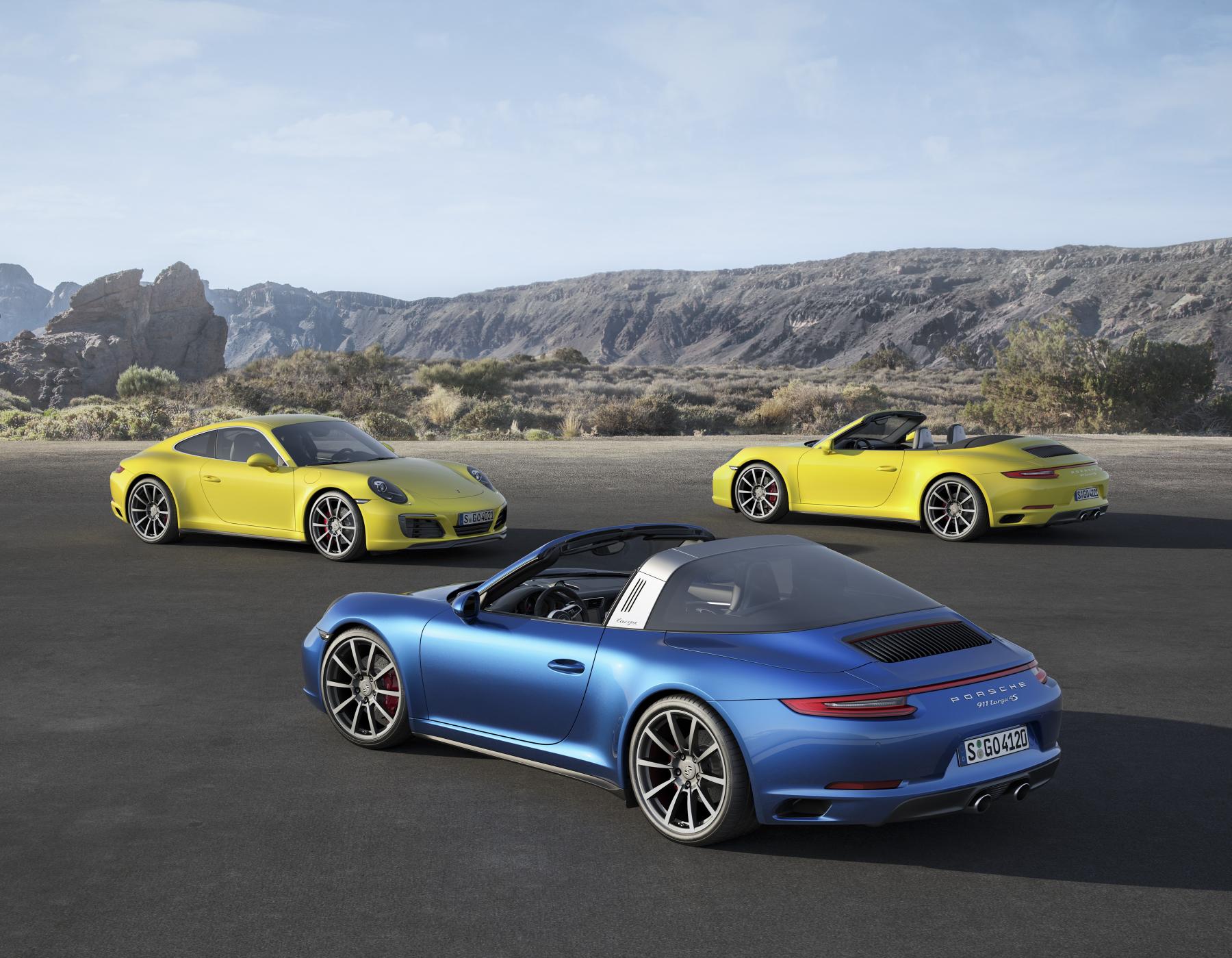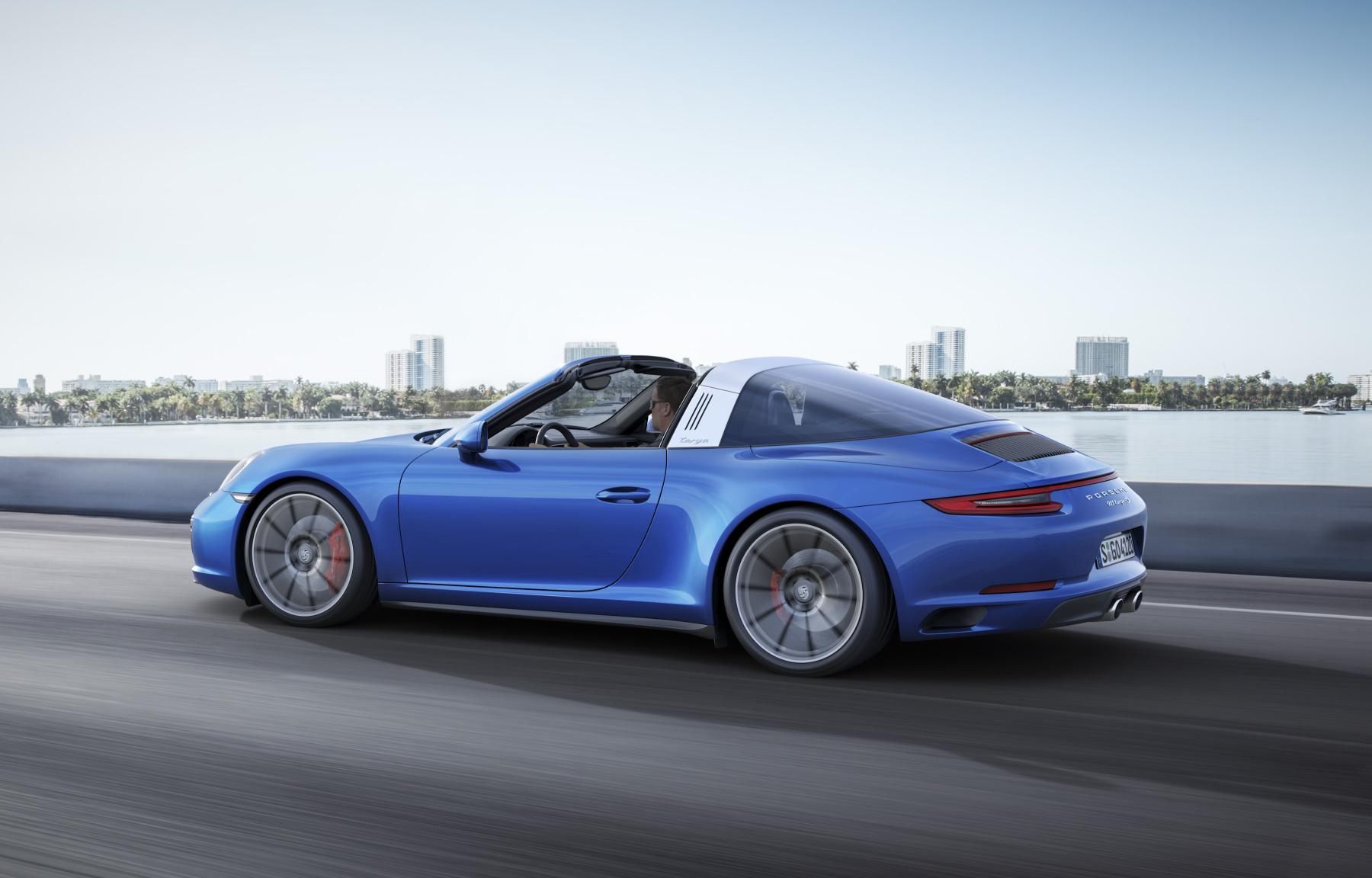
More efficient and powerful all-wheel drive 911 models will reach U.S. dealers in April 2016
ATLANTA, Oct. 6, 2015 — With the new 2017 911 Carrera 4 and 911 Targa 4 models, the traction advantage courtesy of an enhanced all-wheel drive system is paired with innovative turbocharged engines that are more powerful and consume less fuel than their predecessors. The standard adaptive PASM chassis (Porsche Active Suspension Management) with its ten-millimeter reduced ride height provides an even greater bridge between agile handling and sophisticated ride comfort. Rear-axle steering is available as an option for the Carrera 4S models and enhances the car’s agility even further. The standard Porsche Communication (PCM) connectivity and infotainment system with a multi-touch display offers simplified usability.
The all-wheel drive models feature the numerous optical refinements of the new 911 Carrera models, including headlights with four-point daytime running lights, door handles without recess covers, a redesigned rear decklid with vertical louvers, and new rear lights with characteristic four-point brake lights. Additionally, the Carrera 4 and Targa 4 variants are distinguished by a light strip between the rear lights which is now particularly distinctive thanks to its three-dimensional design. When illuminated, it reinforces the impression of depth. The light strip also underlines the wider body of the all-wheel drive 911, with the rear width increased by 44 millimeters over the two-wheel drive models.
The refined look of the new 911 range also underlines the sophisticated elegance of the Targa. With its individual design, the new 911 Targa continues to stand out from the Coupé and Cabriolet. It combines the classic Targa design with an advanced roof in spectacular fashion. Like the legendary original Targa, it has the characteristic Targa bar in place of B pillars, a retractable roof section over the front seats, and a wrap-around rear window without C pillars. The roof segment can be opened and closed at the push of a button, with the soft top being stowed behind the rear seats as it opens.
Faster acceleration, reduced fuel consumption
More than four decades of experience with turbocharged Porsche engines used in motor racing and on production sports cars went into the development of the new flat six engines. The result: a new three-liter, flat six twin-turbo engine that sets new standards in performance, driving pleasure, and efficiency, while offering a 20 hp increase compared to the previous engine generation. Thanks to twin-turbo technology, the three-liter, six cylinder engines in the 911 Carrera 4 and 911 Targa 4 develop 370 hp and 331 lb.-ft. of torque. Using turbochargers with modified compressor wheels, a model-specific exhaust system, and different tune for the engine management system, the 4S models deliver 420 hp and 368 lb.-ft. of torque. Both engines offer significantly greater torque than their predecessors, which is available across a broad power band from 1700 to 5000 rpm.
Thanks to the new electro-hydraulically controlled all-wheel drive, the 911 Carrera 4 accelerates even better than its comparable two-wheel drive counterpart for the first time. Equipped with PDK and Sport Chrono package, the 911 Carrera 4 sprints from zero to 60 miles per hour in 3.9 seconds (0.3 seconds quicker than the previous model), with the S model taking 3.6 seconds (0.3 seconds less). Targa and Cabriolet models need just 0.2 seconds longer. Top track speeds range from 178 to 189 miles per hour, depending on the transmission and model variant. All 911 Carrera 4 and Targa 4 models come with a seven-speed manual transmission as standard.
Traditionally, every new generation of engines from Porsche combines more output with less consumption. The new all-wheel drive 911 models are up to 12 percent more efficient than their respective predecessors, according to the New European Driving Cycle. EPA figures will be available at a later date.
Adopted from the 918 Spyder: Sport Chrono package with mode switch
In conjunction with the optional Sport Chrono Package, the new 911 models now have a mode switch on the steering wheel for the first time, which has been derived from the hybrid map switch in the 918 Spyder super sports car. The mode switch consists of a rotary dial with four positions for the driving modes “Normal”, “Sport”, “Sport Plus,” and “Individual”. Depending on the optional equipment installed in the car, the “Individual” setting lets drivers configure their own individual vehicle setup for the PASM, PDK shifting strategy, and Sport Exhaust system. In conjunction with the PDK transmission, the mode switch has an additional feature, the “Sport Response Button.” When this button is pressed, the drivetrain is pre-conditioned for maximum acceleration for up to 20 seconds.
Re-engineered PASM chassis, enhanced electro-hydraulically controlled all-wheel drive
A Porsche 911 with all-wheel drive combines exceptional traction with particularly sporty handling and driving performance. In this new generation, the electro-hydraulically controlled all-wheel drive adopted from the 911 Turbo responds even more quickly and sensitively. This particularly helps aid driver control during sporty driving while maintaining agility. The PASM sport suspension, which lowers the ride height by 10 millimeters compared to the previous model, is fitted as standard to all Carrera models and aids stability during cornering. The new shock absorber generation offers enhanced ride comfort through an even more refined responsiveness, but also reduces body roll during hard cornering.
Rear axle steering is available as an option for the Carrera 4S coupe, Carrera 4S cabriolet, and Targa 4S, adopted from the current 911 Turbo and 911 GT3. It increases the turn-in agility of the 911 and aids driver control during lane changes. At the same time, it ensures greater maneuverability in city traffic thanks to a 1.6 foot reduction of the turning radius. The improved handling is transmitted to the driver via the new steering wheel generation with a design based on that found in the 918 Spyder. The standard steering wheel has a diameter of 375 millimeters; the optional GT Sport steering wheel measures 360 millimeters. For enhanced everyday practicality, Porsche offers an optional electro-hydraulic lift system with lifting cylinders that are integrated into the front axle struts. Ground clearance at the front spoiler lip can be increased by 40 millimeters within five seconds at the touch of a button. This is particularly useful when encountering speed bumps or steep driveways.
Connectivity and infotainment system: PCM with multi-touch display and new functions
The completely new PCM connectivity and infotainment system is standard and integrates new functions around the multi-touch display in the center console that now has a seven-inch format. Also fitted as standard, the navigation system can be operated much more like a smartphone and can also process handwritten input. Drivers can access real-time traffic information with a free one-year subscription. In addition, compatible mobile phones and smartphones can now be integrated more quickly, easily, and extensively than before via Wi-Fi, Bluetooth or cable. Vehicle-related services such as remote retrieval of vehicle data and Internet-based services such as Google® StreetView and Internet radio are also included in a free one-year subscription.
The new 2017 Porsche 911 Carrera 4 and 911 Targa 4 range will be available in the U.S. beginning in April 2016. U.S. pricing is listed below, excluding a destination charge of $995:
| 911 Carrera 4 | $ 96,300 |
| 911 Carrera 4S | $ 110,300 |
| 911 Carrera 4 Cabriolet | $ 108,600 |
| 911 Carrera 4S Cabriolet | $ 122,600 |
| 911 Targa 4 | $ 108,600 |
| 911 Targa 4S | $ 122,600 |

